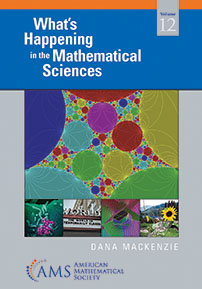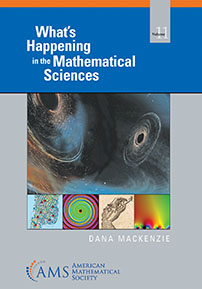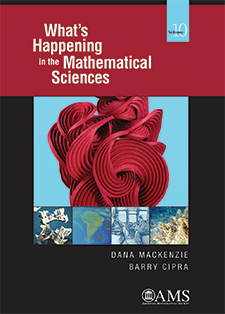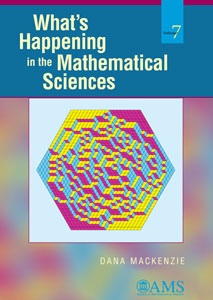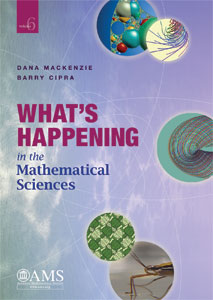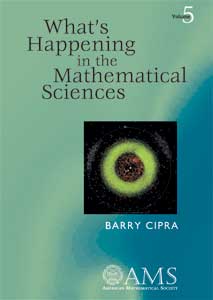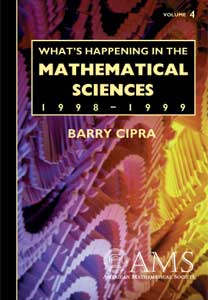
What's Happening in the Mathematical Sciences
What's Happening in the Mathematical Sciences is a series of publications that report on the latest mathematical research in a way that both mathematicians and non-mathematicians can appreciate.
The table of contents of each and the full text of selected articles are below.
- Table of Contents, Volume 12
- Table of Contents, Volume 11
- Table of Contents, Volume 10
- Table of Contents, Volume 9
- Table of Contents, Volume 8
- Table of Contents, Volume 7
- Table of Contents, Volume 6
- Table of Contents, Volume 5
- Table of Contents, Volume 4
- Table of Contents, Volume 3
- Table of Contents, Volume 2
- Table of Contents, Volume 1
Order What's Happening in the Mathematical Sciences, Volume 12 on the AMS Bookstore
Table of Contents, Volume 12
Fifty Ways to Beat a Virus (Part 1)
In 2020, the world for the first time in a century confronted a global pandemic that would claim millions of lives. While students were sent home and campuses closed, many mathematicians found an opportunity to join the fight against COVID-19. Even simple differential equation models can teach us important lessons about the exponential growth of a new epidemic and the importance of threshold behavior. Using more elaborate (and realistic) models, two mathematical modeling groups, in Texas and Illinois, had a profound and positive effect on the management of the epidemic by local and state authorities during the first waves.
Fifty Ways to Beat a Virus (Part 2)
Continuing the previous chapter, Part 2 discusses the problems confronted by mathematicians and epidemiologists in the later part of 2020 and in early 2021. How could universities re-open safely? How does the uncontrolled spread of an epidemic in prisons affect the surrounding community, and what can be done about it? And the biggest question: could vaccination bring the epidemic under control? Even though the coronavirus kept throwing surprises at us, mathematicians did a surprisingly good job of developing strategies, giving realistic answers and highlighting the main reasons for uncertainty.
Fifty Ways to Beat a Virus (Part 3)
Another important front in the battle against COVID-19 was to understand how the infection progresses within the human body. Why do some people have life-threatening symptoms, while others have none at all? An online group called the “Immune Gals” highlighted the delayed release of interferon as a characteristic marker of severe cases. Another mathematician used the tools of graph theory to identify parts of the viral RNA that are especially vulnerable to attack by drugs or gene therapy. And a third group adapted a machine-learning language model to detect escape variants of coronavirus. In effect, they taught the computer to “speak virus.”
Descartes' Homework
A homework problem assigned in 1643 by René Descartes to his star pupil, Princess Elizabeth of Bohemia, backfired when Descartes himself couldn’t solve it. But he redeemed himself by solving a special case that still fascinates geometers and number theorists. Descartes’ theorem and its generalizations have revealed startling symmetries in infinite foams (called Apollonian packings) that are created by squeezing circles as tightly as possible into the spaces created by other circles. New Apollonian and Apollonian-like patterns continue to be discovered in the plane, in 3-space, and in higher dimensions all the way up to dimension 20.
Square Pegs and Squiggly Holes
A century-old “folklore problem” in topology asks whether any continuous loop in the plane that does not cross itself must contain four points that form a perfect square. This is known as the Square Peg Conjecture. Recently, a team of two geometers proved something even better: if the curve is smooth (i.e., it has no corners or cusps) then it contains rectangles of all conceivable shapes, and also quadrilaterals of any shape that will fit snugly in a circle. Their proof ingeniously weaves together 2000-year-old theorems of Euclidean geometry with less than 20-year-old theorems of symplectic geometry.
Dancing on the Edge of the Impossible
The ultimate dream of many number theorists would be an algorithm that inputs a polynomial equation and outputs all the rational solutions to that equation. For equations with integer coefficients in one variable, it’s easy. For equations with nine or more variables, it’s impossible. But equations in two variables are right on the edge. Faltings’ theorem, proved in 1983, guarantees (for most such equations) that there are only finitely many solutions… but it doesn’t say whether there are four or four million. Number theorists are now inching closer to an “effective” Faltings theorem that would tell them when they can stop looking for more solutions.
A Climate for Math
Unprecedented heat waves. Orange skies. Ten-thousand-year floods. When the weather gets weirder than ever before, whom are you going to call? A climatologist, sure. But you might want to talk with a mathematician, too. This chapter explains how mathematical techniques like extreme value analysis, differential equations, changepoint analysis, and machine learning can give us some idea of what has happened already and what will happen next in climate change.
Much Ado About Zero
What is the friendliest research community in mathematics? You could make a good case for zero-forcing. This mash-up of linear algebra and graph theory has been in existence for less than 20 years, but has attracted a large following, with a sizeable proportion of young mathematicians and people from diverse academic and social backgrounds. Zero-forcing is a way to turn hard problems about eigenvalues of matrices into easy games played on graphs (i.e., dot-and-line networks). Or vice versa, it’s a way to turn simple graph games into challenging math problems. Applications to quantum control and electrical and civil engineering are the icing on the cake.
Order What's Happening in the Mathematical Sciences, Volume 11 on the AMS Bookstore
Table of Contents, Volume 11
Gerrymandering: Mathematics on Trial
In the last ten years, mathematicians have developed much more sophisticated methods to detect partisan gerrymandering (i.e., the redrawing of election districts to favor one political party). Unfamiliar words like “outliers” and “efficiency gap” were heard in the US Supreme Court. Though the court eventually withheld its endorsement of any such methods, awareness of the issue among mathematicians reached an all-time high.
The Calculus of Calories
Dieting comes down to a simple equation: Energy stored = energy intake – energy expenditure. If only it were so easy! Mathematicians have developed new algorithms and smartphone apps to help you take the weight off. But they have also made surprising and sobering discoveries about the ways in which your body will fight to put the weight back on.
When Black Holes Collide
One of the boldest predictions of Einstein’s theory of general relativity was the possibility of ripples in spacetime, called gravitational waves. The biggest roadblock to detecting them was figuring out what these waves should “sound like.” In 2015, astrophysicists finally heard the mathematically predicted chirp of two black holes colliding, a billion light-years away and a billion years ago.
The Shape of Data
A new hybrid of statistics and topology, called topological data analysis, uses tools like persistent homology to uncover hidden geometric structures in data, such as loops and bubbles. Applications have run the gamut from figuring out how rat brains encode spatial information to finding optimal molecular structures for porous molecules called zeolites.
The "Set®" Game Has Met Its Match
A popular card game leads to an unexpectedly challenging problem on arithmetic progressions in finite vector spaces, known as the Cap Set Conjecture. In 2016, mathematicians discovered an unexpectedly simple solution. A very rough analog is that it you don’t need too many stars in the sky before you’ll start seeing “three-in-a-row” patterns like the belt of Orion. (Four in a row, though, is another story!)
The Mathematics of Commuting
Bike-sharing systems (like New York’s CitiBike) and ridesharing services (like Uber and Lyft) have led to an explosion of interest in optimization problems. How do you move bikes efficiently from hubs with too many to hubs with too few? How much could traffic congestion be reduced if people shared Uber rides? And what would be the effect of a door-to-door solution that combined bike sharing with ride sharing?
Expanding Horizons
Expanding graphs, or expanders, have multiple personalities. They are networks that are hard to cut in two; networks in which information propagates rapidly; and networks with a large “spectral gap.” In recent years their applications have become even more numerous than their personalities. This chapter explains how they are used in coding, knot theory, and nearest-neighbor search, plus a surprising generalization to hypergraphs.
Quantum Computers and Golden Gates
Even as the U.S. government invests more than $1 billion in quantum computing, fundamental questions remain about how (or if) quantum computers will work. A universal computer needs to use a small vocabulary of elementary “gate” operations to place several quantum bits (qubits) into any target state, with some guarantee of efficiency and accuracy. Mathematicians have now obtained such guarantees for single-qubit operations, using “golden gate” sets.
Needles in an Infinite Haystack
The “asymptotic Fermat’s last theorem” (AFLT), a generalization of the most famous theorem in number theory, can in many cases be reduced to solving the ultra-simple equation x + y = 1, but with restrictions on the prime divisors of x and y. Though theory says there are only finitely many solutions, finding them has been like combing through an infinitely large haystack. Until 2018! Now it can be done (and many cases of AFLT proved) entirely by computer.
Order What's Happening in the Mathematical Sciences, Volume 10 on the AMS Bookstore
Table of Contents, Volume 10
Origami: Unfolding the Future
The ancient Japanese art of paper-folding is going high-tech, as engineers invent new devices that deploy or undeply folding. These inventions lead in turn to challenging mathematical problems about assembly pathways, defects, and curved folds in flat materials.
Prime Clusters and Gaps: Out-Experting the Experts
Mathematics got its real-life Walter Mitty story in 2013, when Yitang Zhang shocked number theorists with the first finite upper bound on the minimum size of prime gaps. One of the oldest problems in number theory, the Twin Prime Conjecture, may now be within reach.
The Truth Shall Set Your Fee
When you pay a stranger, especially online, for help, how can you be sure you're getting honest answers? A new theory in computer science shows how rational self-interest dovetails with the pressing need for trustworthy computation.
Climate Past, Present, and Future
Change is everywhere you look in Earth’s climate, and always has been. Throughout climate science, mathematical models help sort out what did happen (mass extinctions), what is happening (melting ice sheets), and what might happen (tipping points).
Following in Sherlock Holmes' Bike Tracks
In a story published in 1905, Sherlock Holmes incorrectly deduced which way a bicycle went, on the basis of its tracks. The subtle relationship between a bike’s front and rear tracks recently helped mathematicians solve another Victorian-era problem on the operation of planimeters.
Quod Erat Demonstrandum
A proof is a kind of mathematical poem—and sometimes an epic one, at that. Two recent proofs, each years in the making, show the lengths to which mathematicians will go in the dogged pursuit of truth, including, these days, enlisting computers to double check their logic.
The Kadison-Singer Problem: A Fine Balance
Great problems come in many disguises. The Kadison-Singer problem, first posed as a problem in theoretical physics, popped up in many other mathematical contexts over more than half a century until it was finally solved in 2013 graph theorists.
A Pentagonal Search Pays Off
Finding shapes that tile the plane isn’t hard to do. Finding all of them is trickier. Mathematicians still don't know how many different convex pentagons are capable of tiling the plane. But the list, long stalled at 14, just inched up, thanks to a new algorithm and a computer search.
The Brave New World of Sports Analytics
In the last few years, professional sports have been swept a new wave of statistical methods, or “analytics.” These methods, coupled with new data sources like video capture, quantify elusive skills and challenge cherished assumptions about in-game strategy.
Table of Contents, Volume 9
Massive Breakthrough
In 1963, Peter Higgs predicted the existence of the Higgs field, which explains why many subatomic particles have nonzero mass. This prediction was based on a mere page of mathematical calculation and an inspired analogy with the Landau-Ginzburg theory of phase transitions. Almost half a century and more than $9 billion later, experimental physicists at CERN finally chased down the Higgs boson, the most elusive quarry in physics. The discovery filled in the last missing piece of the Standard Model of quantum physics, and spectacularly vindicated the use of abstract symmetry principles to discover new physical phenomena.
Tubing through Hyperspace
In 2012, geometers in rapid succession solved three open problems concerning optimal geometries of tori (inner tubes). The Willmore Conjecture identified the torus with least bending energy; the Lawson Conjecture identified the torus in the hypersphere (a sphere in four-dimensional space) with the least surface area; and the Pinkall-Sterling Conjecture classified all of the tori in the hypersphere that minimize area subject to a volume constraint. Tubing has never been so much fun!
Tsunamis: Learning from Math, Learning from the Past
The great Japanese tsunami of 2011 killed more than 15,000 people in a country that had been better prepared for tsunamis than any other in the world. The tragedy highlighted gaps in our scientific understanding of this hugely destructive natural phenomenon, and even more so in the public’s understanding. It also pointed out some ways in which mathematical models got it right, but not fast enough.
Today's Forecast: Ten Percent Chance of Burglary
An interdisciplinary team at UCLA discovered how to adapt a mathematical model developed for earthquake prediction to identify likely crime “hot spots.” Two field tests of their software were resounding successes, and predictive policing was recognized in Time magazine and other media outlets as one of the top scientific discoveries of 2011.
Topologists Cross Four Off "Bucket List"
Three decades ago, three-dimensional topology seemed like a wild, untamed jungle of disparate examples. Then William Thurston proposed a series of conjectures that brought some order to the chaos. In 2012, just months before Thurston’s death, the Virtual Haken Conjecture and Virtual Fibering Conjecture were finally proved, showing that almost all three-dimensional manifolds are descended from templates constructed in an elementary fashion.
Mathematicians Do the Twist
Rubik’s cube, the mathematician’s favorite toy, continues to attract new fans and inspire new research. While “speedcubers” developed new algorithms (and manual dexterity) to solve the cube in less than 10 seconds, mathematicians proved that an omniscient being could always solve the classic, 3-by-3-by-3 cube in 20 moves or less.
The Right Epidemic at the Right Time
In 2009 the world experienced its first flu pandemic in forty years. Fortunately it turned out much milder than the three great pandemics of the twentieth century, but it provided an ideal opportunity to test a variety of mathematical simulations in real time. Conclusions: The simulations worked pretty well, and communications between modelers and field workers were excellent, but the late delivery of vaccine would have been a fiasco in a worse epidemic.
Thinking Topically
Topic modeling is a new statistical technique named after its ability to identify topics (such as genetics or climate change) in a large body of documents. While still in its early days, it has proved hugely popular in the fields of “digital humanities” and it might enable social-networking websites to respond automatically and anonymously to cyber-bullying.
Thinking Tropically
Blessed (or perhaps cursed?) with a catchy name, tropical geometry enables mathematicians to solve difficult problems in classical algebraic geometry by making simple combinatorial models that look a lot like stick figures. This new type of geometry also has surprising applications to string theory in physics, evolutionary trees in biology, and the scheduling of trains.
Unfortunately, Volume 9 is no longer available.
Table of Contents, Volume 8
Accounting for Taste
Netflix, a movie rental company, offered a million-dollar prize for a computer algorithm that could significantly upgrade the company's ability to predict its customers' likes and dislikes. The wildly successful competition upset some conventional wisdom in the field of machine learning and vividly demonstrated the power of "crowdsourcing."
A Brave New Symplectic World
Thirty years ago, Alan Weinstein conjectured that certain kinds of dynamical systems with two degrees of freedom, such as a pendulum that is free to stretch as well as swing, always have periodic (repeating) solutions. At the time, no one had any idea how to prove his conjecture. But that was before "symplectic camels" and a "crazy" homology theory based on the equations for a magnetic monopole. Conclusion: Periodic orbits exist. (Magnetic monopoles still don't.)
Mathematics and the Financial Crisis
In the first decade of the 2000s, investors embraced credit derivatives: a clever, formula-based method to parcel out the risk of subprime loans and profit from a booming housing market. But they forgot--or chose to ignore--that a mathematical model is only as good as its assumptions.
The Ultimate Billiard Shot
In an inside-out version of billiards that you can't quite fit into your garage (or even the Milky Way), two groups of researchers find different ways to sink the cue ball into a pocket at infinity.
SimPatient
Mathematical models of patient populations have begun to supplement or replace clinical trials in cases where the trials would be difficult or impossible to perform. In 2009, a public health panel used six breast cancer models to arrive at a controversial recommendation that women aged 40-49 should no longer be advised to have an annual mammogram.
Instant Randomness
How long does it take to mix milk in a coffee cup, neutrons in an atomic reactor, atoms in a gas, or electron spins in a magnet? In the Ising model of magnetism, mathematicians have calculated a unique cutoff time when the system abruptly goes from essentially unmixed to almost completely mixed. The same behavior is expected for other systems described by the theory of Markov chains.
In Search of Quantum Chaos
A classical billiard ball, on a table with curved, "dispersing" sides, travels on a chaotic trajectory that essentially randomizes the ball's position over the long term. However, at low energies, quantum billiard balls are not chaotic. In a tour de force combining pure number theory with physics, mathematicians proved that quantum chaos does emerge at high energies.
3-D Surprises
Even in the twenty-first century, mathematics can still reveal new phenomena in ordinary three-dimensional space. Item 1: a stunningly efficient way to pack tetrahedra. Item 2: the Gömböc, a homogeneous body that automatically rights (and wrongs) itself.
As One Heroic Age Ends, a New One Begins
John Milnor's discovery of "exotic spheres" in 1956 ushered in a new era of high-dimensional topology, with powerful new tools like framed cobordism theory, stable homotopy theory, and surgery. But one question, called the Kervaire Invariant One problem, remained stubbornly unanswered for more than 40 years, until three topologists found "a shortcut to Mount Everest."
Unfortunately, Volume 8 is no longer available.
Order What's Happening in the Mathematical Sciences, Volume 7 on the AMS Bookstore
Table of Contents, Volume 7
A New Twist in Knot Theory
(![]() 846 KB)
846 KB)
Two seemingly unrelated kinds of knots--modular knots and Lorenz knots--turn out to be the same. For number theorists, the payoff is a new way to look at an old concept, the modular surface. For dynamical systems theorists, it's a new way to understand the beginnings of chaos.
Error-term Roulette and the Sato-Tate Conjecture
Fifteen years ago, Andrew Wiles proved Fermat's Last Theorem, thereby solving the most famous problem in mathematics. The aftershocks are still being felt. A team of number theorists, including Wiles collaborator, Richard Taylor, adapts Wiles' machinery to polish off another celebrated unsolved problem in number theory.
The Fifty-one Percent Solution
(![]() 846 KB)
846 KB)
Persi Diaconis, Susan Holmes and Richard Montgomery tell you how to get the odds in your favor the next time you flip a coin. And no, you don't have to cheat.
Dominos, Anyone?
An innocent puzzle about tiling a checkerboard with dominos leads, ultimately, to a new model of random surfaces. The theory is both simple enough to be exactly solvable, and complex enough to include phase transitions between "solid," "liquid," and "gaseous" states--a combination that has never occurred previously in statistical physics.
Not Seeing Is Believing
New "metamaterials" may soon bring invisibility cloaks--and inaudibility cloaks, too--out of the realm of fantasy and into reality. Unlike Harry Potter's cloak, these devices will work strictly on the principles of mathematics, not magic.
Getting with the (Mori) Program
In algebraic geometry, the Mori Minimal Model Program is an ambitious effort to match the geometry of surfaces defined by polynomial equations to their algebra. After 100 years of carrying out the program one dimension at a time, algebraic geometers race to the top of the ladder.
The Book that Time Couldn't Erase
More than 1000 years ago, an unknown scribe copied some of Archimedes' works onto parchment. But 200 years later, another scribe erased them and wrote a prayer book over the top. Over the last ten years, high-tech imaging methods have penetrated through the damage done by centuries of neglect and abuse to reveal what Archimedes, the greatest mathematician of ancient Greece, really wrote.
Charting a 248-dimensional World
Racing against time and the incurable illness of one of their colleagues, a team of twenty group theorists puts together a detailed survey of "the most beautiful structure in mathematics"-- the exceptional Lie group, E8.
Compressed Sensing Makes Every Pixel Count
(![]() 878 KB)
878 KB)
Proving that more is not always better, mathematicians show that "sparse" or "compressible" signals, such as digital photographs and cell phone messages, can be reconstructed from many fewer measurements than engineers previously supposed. As an extreme proof of principle, engineers design the world's first single-pixel camera.
Order What's Happening in the Mathematical Sciences, Volume 6 on the AMS Bookstore
Table of Contents, Volume 6
See links to Cipra and Mackenzie talking about the subject of each chapter.
First of Seven Millennium Problems Nears Completion
by Barry Cipra (![]() 1 MB)
1 MB)
 hear the podcast interview with the author
hear the podcast interview with the author
In 2002, Grigory Perelman announced a solution to the Poincaré Conjecture, a problem in topology selected in 2000 as one of the seven leading math challenges of the millennium. After more than three years of scrutiny, mathematicians are cautiously accepting his proof, which uses a geometric partial differential equation called "Ricci flow," first studied by Richard Hamilton.
Classifying Hyperbolic Manifolds--All's Well that Ends Well
by Dana Mackenzie (![]() 1.62 MB)
1.62 MB)
 hear the podcast interview with the author
hear the podcast interview with the author
While three-dimensional topologists awaited a verdict on the Poincaré Conjecture (which deals with closed manifolds), several of them solved a suite of long-standing conjectures about the ends of open manifolds.
Digits of Pi
by Barry Cipra (![]() 317 KB)
317 KB)
 hear the podcast interview with the author
hear the podcast interview with the author
Pi lovers rejoice! You can now stick your finger into pi and pluck out any digit (say, the trillionth one) without having to compute all the preceding digits. The only catch is that you have to count in sixteens.
Combinatoricists Solve a Venn-erable Problem
by Barry Cipra (![]() 415 KB)
415 KB)
 hear the podcast interview with the author
hear the podcast interview with the author
A question posed by an undergraduate student--can a Venn diagram be rotationally symmetric?--leads to some beautiful "doilies," intricate mathematics, and (after forty years) a solution found by another student.
New Insights into Prime Numbers
by Barry Cipra ( hear the podcast interview with the author)
hear the podcast interview with the author)
numbers surprised number theorists. A team of Indian mathematicians, including two students, discovers the first polynomial-time algorithm for testing to see if a number is prime. American, Turkish, and Hungarian mathematicians collaborate to show that small gaps between consecutive primes occur much more often than anyone had previously proved. And another international collaboration finds evenly spaced (but non-consecutive) prime sequences of any desired length.
From Rubik's Cube to Quadratic Number Fields ... and Beyond
by Dana Mackenzie ( hear the podcast interview with the author)
hear the podcast interview with the author)
Manjul Bhargava started with a simple idea of putting numbers into a box. What came out of the box, eventually, was a whole new way to combine and to count objects in algebraic number theory.
Vortices in the Navier-Stokes Equations
by Barry Cipra ( hear the podcast interview with the author)
hear the podcast interview with the author)
From Jupiter's Great Red Spot to the eddies in a stream, vortices are a familiar feature of fluid flow. Mathematicians have gained new insights into the formation and long-term survival of vortices in both two- and three-dimensional fluids.
Fluid Dynamics Explains Mysteries of Insect Motion
by Dana Mackenzie (![]() 735 KB)
735 KB)
 hear the podcast interview with the author
hear the podcast interview with the author
How do water striders move on a nearly frictionless surface? How do dragonflies hover? These and other conundrums of biology can be explained by the mathematics of the Navier-Stokes equations.
Brownian Motion, Phase Transitions, and Conformal Maps
by Dana Mackenzie ( hear the podcast interview with the author)
hear the podcast interview with the author)
A new random process called Schramm-Loewner evolution turns out to be a good model for a variety of physical phenomena, from the random jitters of air molecules to phase transitions of a magnetic material. The key mathematical property of these systems, proven in some cases and still conjectural in others, is conformal invariance.
Smooth(ed) Moves
by Barry Cipra ( hear the podcast interview with the author)
hear the podcast interview with the author)
Some algorithms of computer science, such as the simplex algorithm for solving linear programming problems, work better than they are supposed to. A new measure of complexity, called smoothed analysis, shows why the standard worst-case scenarios are so misleading.
Order What's Happening in the Mathematical Sciences, Volume 5 on the AMS Bookstore
Table of Contents, Volume 5
New Heights for Number Theory
Progress proceeds apace in the post-Fermat world of elliptic curves and modular forms.
A Mathematical Twist to Protein Folding
Powerful statistical methods are helping researchers elucidate the three-dimensional structure of life's most important molecules.
Nothing to Sphere But Sphere Itself
A centuries old problem--the Kepler conjecture--has yielded to new insights and some dogged computation.
Finite Math
Is the universe finite? Observations of the cosmic microwave background and a new mathematical algorithm may provide an answer.
The Mathematics of Traffic Jams
Computer models are helping researchers understand where traffic jams come from--and maybe what to do about them.
Rewriting History
Plimpton 322 is one of mathematicians' favorite cuneiform tablets. But what did it mean to the scribe who composed it?
It's a Small, Big, Small, Big World
Researchers have found a short distance from theory to applications in the study of small world networks.
A Celestial Pas de Trois
New methods have revealed a multitude of solutions to an old problem in celestial mechanics: the orbital motion of three bodies.
Think and Grow Rich
The Clay Mathematics Institute has singled out seven important problems in mathematics, with a $1 million dollar prize for each.
Ising on the Cake
A new theorem helps explain why statistical physics has had such a hard time with one of its central problems.
Order What's Happening in the Mathematical Sciences, Volume 4 on the AMS Bookstore
Table of Contents, Volume 4
A Blue-Letter Day for Computer Chess
Deep Blue's victory over Garry Kasparov is the end of a long road in computer chess, but the mathematical study of "perfect" play in combinatorial games has an even longer ways to go.
A Prime Case of Chaos
Quantum chaologists and analytic number theorists have their sights set on a mysterious mathematical object: the Riemann zeta function. (Please Note: This article is available in PDF format.)
Proof by Example: A Mathematician's Mathematician
Paul Erdős, the "Johnny Appleseed" of mathematics, inspired hundreds of colleagues and left a rich legacy of mathematical problems--and solutions.
Computers Take Algebraic Geometry Back to Its Roots
Computer power has brought algorithmic questions in algebraic geometry back to the fore.
As Easy as EQP
An automated theorem prover succeeeds in settling a decades-old conjecture in symbolic logic. What's left for human minds to do?
Beetlemania: Chaos in Ecology
A collaboration between mathematicians and biologists has led to the first experimental evidence for chaotic dynamics in a population.
From Wired to Weird
Mathematical discoveries are shaping research in a potentially revolutionary kind of computing, based on principles of quantum mechanics.
Tales from the Cryptosystem
A breakthrough in the theory of computational complexity has implications for cryptographic systems with "guaranteed" security.
But Is It Math?
Mathematics and art have more in commmon than is commonly supposed. Two twentieth-century artists, M. C. Escher and Marcel Duchamp, used mathematics as an inspiration for works of art.
Mathematical Discovery (by Henri Poincaré)
Henri Poincaré's thoughts on thinking, written near the beginning of the twentieth century, are well worth repeating at century's end.
Order What's Happening in the Mathematical Sciences, Volume 3 on the AMS Bookstore
Table of Contents, Volume 3
Fermat's Theorem--At Last!
Andrew Wiles has completed the astonishing tour de force that resolves the most famous problem in mathematics. His proof is the realization of a boyhood dream.
A Tale of Two Theories
A breakthrough in theoretical physics has simplified a notoriously difficult theory in 4-dimensional geometry, and given mathematicians a lot to think about.
Computer Science Discovers DNA
Will computers of the future be bio-engineered? It's a possibility.
Divide and Conquer
Thomas Nicely set out to study prime numbers that occur in pairs. Along the way, he discovered that Intel's Pentium chip couldn't divide. (Please Note: This article is available in PDF format.)
The Gentle Art of Control
Modern technology relies on mathematical control theory to keep things on an even keel. How do the equations know what to do?
Computational Fluid Dynamics--Verging on Turbulence
Mathematical techniques, faster computers, and better algorithms are gaining ground in the study of complex fluid flows. For some researchers, computtational turbulence is literally a pipe dream.
Cellular Automata Offer New Look on Life, the Universe, and Everything
The continuously increasing power of computers has enabled researchers to take a discrete look at the world. Theorists seek to explain the complex patterns that are often seen.
Are Group Theorists Simple-Minded?
Researchers are working hard to simplify one of the most complicated proofs in mathematical history--the classification of simple groups.
The Secret Life of Large Numbers
A computational challenge in number theory has been met, considerably sooner than the 20,000 years it was expected to take.
In Math We Trust
A theorem about multivariate integration may find a home on Wall Street. You could call it a get-rich-quick scheme.
Table of Contents, Volume 2
"A Truly Remarkable Proof"
The announcement last year of a proof of Fermat's Last Theorem stunned the mathematical world. Andrew Wiles's proof, though currently incomplete, has nonetheless drawn rave reviews.
From Knot to Unknot
What's the quickest way to untie a knot? Researchers have untangled a good part of the answer.
New Wave Mathematics
Will compact waves cruise the information superhighways of the future? In theory, it's possible.
Mathematical Insights for Medical Imaging
A team of mathematicians, computer scientists, and engineers has designed a new medical imaging technology based on the safe application of electric current
Parlez-vous Wavelets?
Mathematicians and scientists are rapidly learning to speak a new language. The results are making a big splash.
Random Algorithms Leave Little to Chance
Computer scientists will do anything to avoid bottlenecks and speed up computations. But gamble on the results? You bet!
Soap Solution
Undergraduate students at a summer mathematics research program have found some slick answers to some old problems about the geometry of soap bubbles.
Straightening Out Nonlinear Codes
A complicated class of error-correcting codes has suddenly gotten much easier to use.
Quite easily Done
A combinatorial problem, long thought to be difficult, has finally been solved--with surprising ease.
(Vector) Field of Dreams
A clever construction "pulls the plug" on a 40-year old conjecture about the topology of vector fields.
Unfortunately, Volume 2 is no longer available.
Table of Contents, Volume 1
Equations Come to Life in Mathematical Biology
Mathematicians are working with biologists to delve into some of the most challenging problems in biology today, from understanding the human immune system to "computing" the human heart.
New Computer Insights from "Transparent" Proofs
Can a computer be trusted when it produces a proof so long and complicated that no human can check the details? Theorists have cooked up a new way to tell whether or not a computer proof is right.
You Can't Always Hear the Shape of a Drum
Can you hear the shape of a drum? is a famous problem that asks if two drums that look different can make the same sound. After decades of head-scratching, mathematicians have come up with the answer.
Environmentally Sound Mathematics
Mathematicians have been teaming up with scientists to work on solving environmental problems, from ocean modeling to dealing with hazardous waste.
Disproving the Obvious in Higher Dimensions
Intuition about our three-dimensional world can be surprisingly misleading when it comes to higher dimensions, as two recent results in geometry show.
Collaboration Closes in on Closed Geodesics
An unusual blend of differential geometry and dynamical systems has led to an important theoretical result about the number of closed "geodesic" curves on distorted spheres.
Crystal Clear Computations
Growing crystals--on a computer? Mathematicians are helping materials scientists to better understand the nature of crystals, while picking up some challenging mathematical problems along the way.
Camp Geometry
A group of talented and inquisitive undergraduates "camped out" last summer at the Geometry Center. Using sophisticated computer graphics and their own imaginations, they came up with some fascinating mathematics.
Number Theorists Uncover a Slew of Prime Imposters
Strange as it may sound, there are composite numbers that "masquerade" as primes. A group of mathematicians trying to hunt down these prime imposters ended up proving there are infinitely many of them.
Map-Coloring Theorists Look at New Worlds
How many colors are needed to distinguish neighboring colors on a map? The famous Four Color Theorem notwithstanding, this is a challenging problem in graph theory--especially when your maps aren't flat.
Unfortunately, Volume 1 is no longer available.


